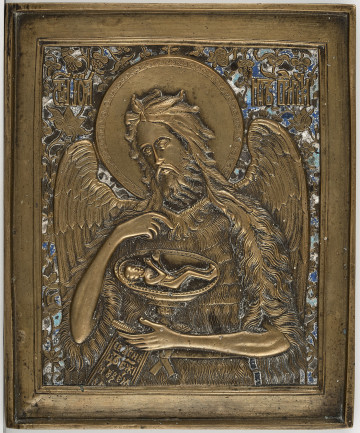
St. John the Baptist
20th century
Castle Museum in Łańcut
Part of the collection: Icons
In Russia, the Theotokos Joy of All Who Sorrow icon was one of the most popular images cast in metal, see S.12800MŁ, S.12806MŁ, S.12863MŁ. The subject of the icon, taken from the liturgical hymn "Rejoice, O Virgin Theotokos, full of Grace, Joy of all who sorrow...", appeared in Moscow's visual arts in the second half of the 17th c., see S.12772MŁ. It was a period of severe clashes between the supporters of reforming the liturgy and rites to comply with the Greek canon of that time, and the supporters of old Rus tradition - opposed to any changes, which they viewed as heresy. The defenders of the old traditions began to be called 'Old Believers' or 'Old Ritualists', and in the sphere of the official, reformed Orthodox Church, they were known as raskolniki - from the Russian word 'raskoł', meaning 'schism'. Fleeing persecution, the Old Believers moved to hard-to-reach areas and formed closed enclaves. One of them was established in the last years of the 12th c., on the Guslitsa River, around 100 km southeast of Moscow. The region, known as Guslitsa, was inhabited by a community of Priested Old Believers ('Popovtsy'), who recognised and used the ministry of priests. In the 19th c., Guslitsa became famous for metal crafts, purchased by both their own faithful as well as by the followers of the official Moscow Orthodox Church. Over time, small workshops began to imitate casts from Guslitsa but did not match the original ones in quality. One of the characteristic elements of Guslitsa metalwork arts and their imitators was the characteristic crowning of the icons and crosses, in the form of winged heads of cherubs, as can be seen on the presented icon of the Theotokos Joy of All Who Sorrow. Teresa Bagińska-Żurawska https://orcid.org/0000-0002-9243-3967
Dimensions
height: 13.2 cm, width: 8.3 cm
Object type
Icons
Technique
cast
Material
bronze, copper alloy
Origin / acquisition method
decyzja administracyjna
Creation time / dating
Creation / finding place
Owner
Castle Museum in Łańcut
Identification number
Location / status

20th century
Castle Museum in Łańcut

19th (?) century
Castle Museum in Łańcut

1800 — 1850
Castle Museum in Łańcut
DISCOVER this TOPIC
Castle Museum in Łańcut
DISCOVER this PATH
Educational path